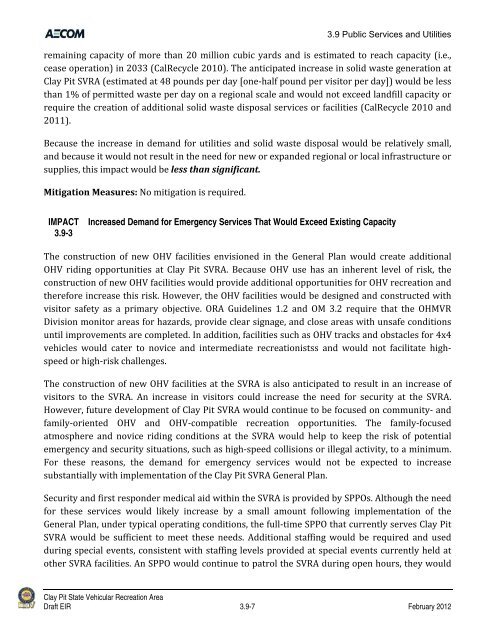Draft Environmental Impact Report - California Off Highway Vehicle ...
Draft Environmental Impact Report - California Off Highway Vehicle ...
Draft Environmental Impact Report - California Off Highway Vehicle ...
You also want an ePaper? Increase the reach of your titles
YUMPU automatically turns print PDFs into web optimized ePapers that Google loves.
3.9 Public Services and Utilities<br />
remaining capacity of more than 20 million cubic yards and is estimated to reach capacity (i.e.,<br />
cease operation) in 2033 (CalRecycle 2010). The anticipated increase in solid waste generation at<br />
Clay Pit SVRA (estimated at 48 pounds per day [one‐half pound per visitor per day]) would be less<br />
than 1% of permitted waste per day on a regional scale and would not exceed landfill capacity or<br />
require the creation of additional solid waste disposal services or facilities (CalRecycle 2010 and<br />
2011).<br />
Because the increase in demand for utilities and solid waste disposal would be relatively small,<br />
and because it would not result in the need for new or expanded regional or local infrastructure or<br />
supplies, this impact would be less than significant.<br />
Mitigation Measures: No mitigation is required.<br />
IMPACT<br />
3.9-3<br />
Increased Demand for Emergency Services That Would Exceed Existing Capacity<br />
The construction of new OHV facilities envisioned in the General Plan would create additional<br />
OHV riding opportunities at Clay Pit SVRA. Because OHV use has an inherent level of risk, the<br />
construction of new OHV facilities would provide additional opportunities for OHV recreation and<br />
therefore increase this risk. However, the OHV facilities would be designed and constructed with<br />
visitor safety as a primary objective. ORA Guidelines 1.2 and OM 3.2 require that the OHMVR<br />
Division monitor areas for hazards, provide clear signage, and close areas with unsafe conditions<br />
until improvements are completed. In addition, facilities such as OHV tracks and obstacles for 4x4<br />
vehicles would cater to novice and intermediate recreationistss and would not facilitate high‐<br />
speed or high‐risk challenges.<br />
The construction of new OHV facilities at the SVRA is also anticipated to result in an increase of<br />
visitors to the SVRA. An increase in visitors could increase the need for security at the SVRA.<br />
However, future development of Clay Pit SVRA would continue to be focused on community‐ and<br />
family‐oriented OHV and OHV‐compatible recreation opportunities. The family‐focused<br />
atmosphere and novice riding conditions at the SVRA would help to keep the risk of potential<br />
emergency and security situations, such as high‐speed collisions or illegal activity, to a minimum.<br />
For these reasons, the demand for emergency services would not be expected to increase<br />
substantially with implementation of the Clay Pit SVRA General Plan.<br />
Security and first responder medical aid within the SVRA is provided by SPPOs. Although the need<br />
for these services would likely increase by a small amount following implementation of the<br />
General Plan, under typical operating conditions, the full‐time SPPO that currently serves Clay Pit<br />
SVRA would be sufficient to meet these needs. Additional staffing would be required and used<br />
during special events, consistent with staffing levels provided at special events currently held at<br />
other SVRA facilities. An SPPO would continue to patrol the SVRA during open hours, they would<br />
Clay Pit State Vehicular Recreation Area<br />
<strong>Draft</strong> EIR 3.9-7 February 2012








